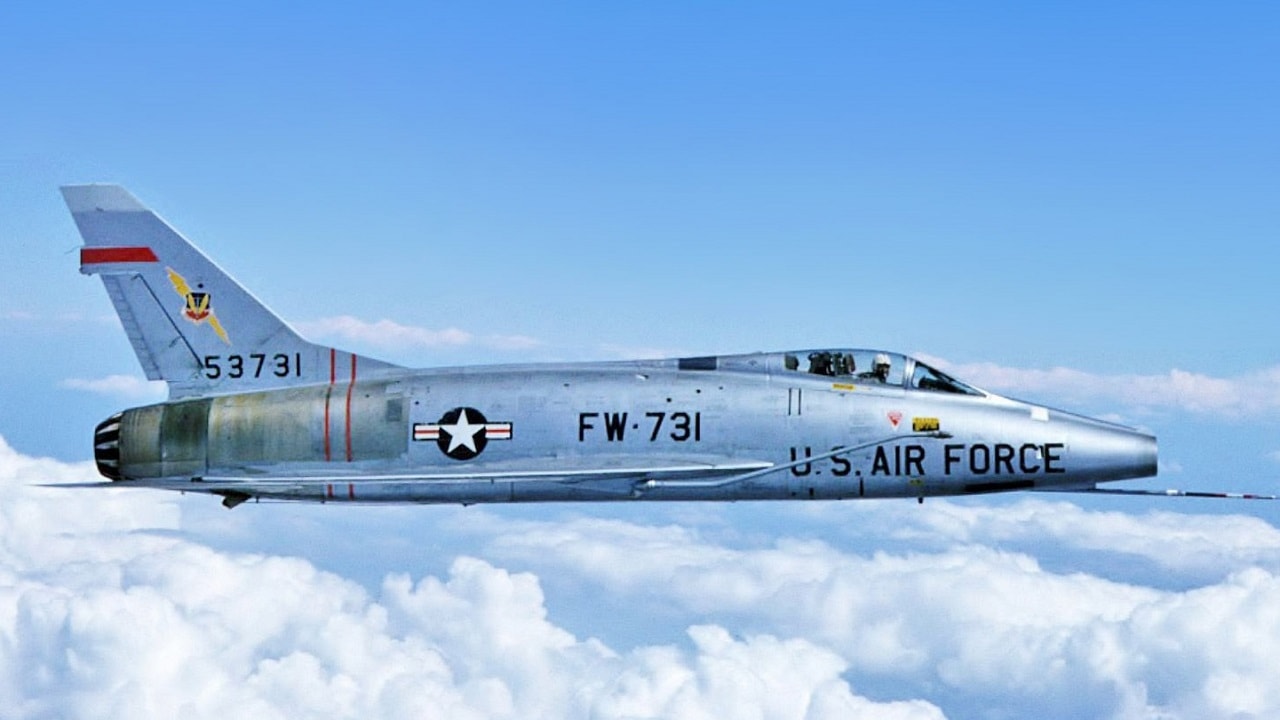The North American Aviation F-100A “Super Sabre” was the first U.S. fighter to achieve supersonic speed in level flight. The F-100A was an upgraded follow-up to the original Sabre, the F-86, and it was the first member of the Century Series. Often referred to as the “Hun,” the F-100’s A-variant was deeply flawed, and it experienced a staggering accident rate. Newer variants addressed the problems of the original, and these went on to serve successfully in the Vietnam War.
An Unsolicited Upgrade
In early 1951, NAA chose to develop an upgraded version of their F-86 – despite never being asked to do so. At the time, the F-86 was engaged in combat over the Korean peninsula, where the swept-wing airframe was a welcome upgrade to the straight-winged fighters that preceded it. The F-86 helped bring Americans closer to parity with North Korea’s Soviet-made jets.
As I wrote in a previous article: “The earliest variants of the F-86, which were rushed from the production line, could not out-turn the nimble MiG-15. However, the F-86 could outdive the MiG. Nevertheless, the MiG remained superior with respect to service ceiling, acceleration, and rate of climb.” By 1953, the F-86’s F-variant would match the MiG-15 more closely. But in 1951, with MiGs still outperforming the F-86, North American Aviation set out to build a better aircraft, something to give American pilots an edge.
Mock-ups of the F-100A were modified extensively. More than 100 alterations were made before the aircraft was accepted and prototypes were built. North American first flew the F-100 prototype, the YF-100A, in 1953, and the U.S. Air Force looked on. In the YF-100A’s first flight, the jet achieved Mach-1.04, despite being fitted with a less powerful XJ57-P-7 engine. The Air Force was impressed, but noted that the new jet had design flaws. Further testing was needed.
Deadly Problems
The F-100 A-variant’s biggest worry was yaw instability, which had a tendency to produce inertia coupling – that is when an airframe experiences uncontrolled spin along multiple axes, meaning it experiences barrel rolls, flat spins and somersaults all at once.
As you might imagine, it is hard to recover from inertia coupling. In the F-100, the inertia coupling was especially problematic because the conditions would cause the airframe to disintegrate. North American’s chief test pilot, George Welch, who was nominated for the Congressional Medal of Honor after being one of the few pilots to get airborne and engage the Japanese during the attack on Pearl Harbor, was killed when his F-100 disintegrated.
The F-100 had another concerning tendency: When the aircraft approached stall speeds, the swept wings often lost lift out in the tips. The result was a spastic pitch-up attitude, which was especially deadly at low altitudes. This pitch-up came to be known as the “Sabre dance.”
Despite the F-100’s troubling flight characteristics, the new jet was ordered into service when the competing Republic F-84F Thunderstreak program was delayed. The F-100A entered service on Sept. 27, 1954. Barely six weeks later, by mid-November, the F-100A had already been involved in six major accidents.
Flight instability, disintegration, hydraulic-systems failure – various fatal problems were bringing down the Super Sabre, prompting the Air Force to ground the entire fleet.
The F-100A fleet was reactivated in September 1955, but the accidents continued. The Air Force began phasing out the troubled A-variant, and the last F-100A left active service in 1961. In barely six years of service, the F-100A was involved in 47 major accidents.
Harrison Kass is the Senior Defense Editor at 19FortyFive. An attorney, pilot, guitarist, and minor pro hockey player, he joined the US Air Force as a Pilot Trainee but was medically discharged. Harrison has degrees from Lake Forest College, the University of Oregon, and New York University. He lives in Oregon and listens to Dokken. Follow him on Twitter @harrison_kass.

